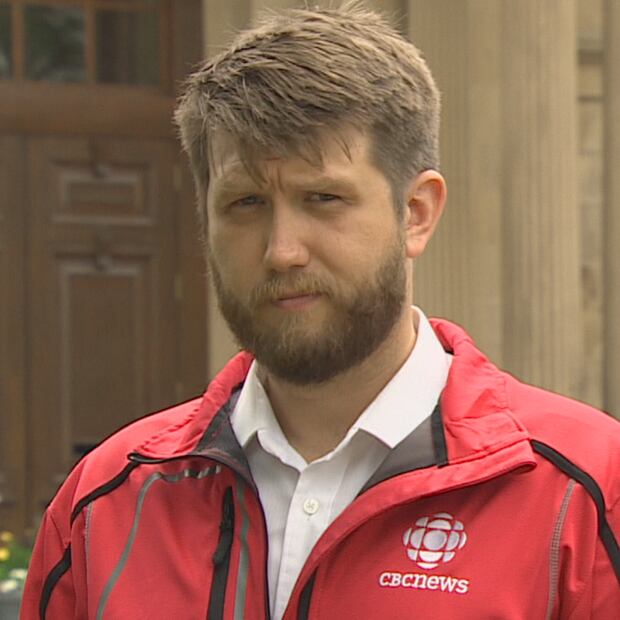Thousands of N.B. licence plates — dumped in the woods — thrill collectors
The plates are in piles according to date, from 1957 to 1960, in a forested area in Fredericton

Robin McQueen has been collecting licence plates since he was a teenager, but he'd never come across a trove of plates like the one he found this summer.
On the outskirts of Fredericton's south side, thousands of New Brunswick plates dating back to the 1950s, are strewn across the forest floor, covering the ground like leaves.
"Walking in there is like Disneyland for licence plate people," McQueen said about the site in the woods near the city's industrial park.
"You'd never know it's there, but it's absolutely polluted with licence plates all over the ground," he said.

Some display an embossed provincial crest. Others have a line that says "Picture Province," a slogan from the mid-20th century that lasted until the officially bilingual New Brunswick added "Nouveau-Brunswick" to its licence plates.
The plate designations show they were intended for all types of vehicles, including heavy trucks, motorcycles, tractors and taxis.
Many are still piled up in the sequence they were produced, separated by decaying strips of wax paper.
Some are in decent enough shape that McQueen has taken them home to clean up and display for his own collection. Others fall apart upon touch — victims of rust, exposure and time.
It's impossible to gauge how many are there. McQueen has tried to dig his way to the bottom of the pile, but after going through several layers, he said there's no end. Just more rusting plates.
"There's so many that you could spend all day, every day, for a long time, trying to pick them up and you would not be able to," said McQueen.

The plates are in piles according to date, from 1957 to 1960. Rusted-out vehicles are also abandoned there, many with the words "Dept. Of Public Works Province of New Brunswick" stenciled on their doors. There are dozens of old washing machines and water heaters.
McQueen was shown this place by a friend who said he'd been going there for 30 to 40 years.
But how did all these plates end up here in the first place?

One man's trash
Gary Doherty has been an avid licence plate collector since 1976. It started when he was a young teenager. He recalled seeing old licence plates on his grandfather's and uncle's barn walls. At the time he assumed that if he had plates, he could drive a car.
"Because I thought if I could drive a car, I could get a girlfriend," said Doherty.
Since then both of his passions have flourished. He and his wife, Gale, have been married for nearly 55 years. He's also come to own between 35,000 and 40,000 licence plates from all over the world.

Licence-plate graveyards like the one in Fredericton aren't new to a seasoned collector like Doherty.
He said while he's never been to this specific location, he has been to others. They're not uncommon throughout the province, if you know where to look. That's because decades ago, vehicles were issued a new plate every year, something Doherty calls "replating."
"Back in the days when New Brunswick and most places used to re-plate every year, they had to order enough plates so that they could restock all of the motor vehicle branches," said Doherty. "When they re-plated, there was always lots of leftovers."
Doherty says those extras were always kept at the motor vehicle offices until they were audited. After that, they were disposed of in a variety of ways.
"Someone would use them to roof over a shed or siding on a house," he said.
But that wax paper in between each of the plates often kept the boxes out of junkyards and scrap yards. That paper was designed to keep plates from scratching and chipping during shipping. But one junkyard owner told him it made recycling them too expensive.
"'It [would] cost more money to hire somebody to separate them, so they can be scrap, than I'd get out of them,'" said Doherty.

"So when that happens, somebody takes a half-ton truckload of boxes of plates out in the middle of the woods where nobody can see them and dumps them."
He said he's heard of at least six other plate graveyards across the province, including near Woodstock, St. Stephen and another one on Fredericton's north side, although he's unable to pinpoint that exact location.
"Most people were not as concerned about the environment ... as we are today," he said.
Complete surprise, say property owners
The piles of licence plates in the woods near the industrial park are on private property. When CBC News contacted the landowners, who have owned the land for nearly 30 years, they said they had no idea the plates were there.
They declined to be interviewed and said they worried about being responsible for cleaning up a mess they did not contribute to and were unaware existed.
CBC News requested an interview with the Department of Transportation and Infrastructure about the possible origins of the licence plates and whether the department is aware of the site. The request was acknowledged but no other response came, even after a follow-up was made.
Jeff Carr is the PC MLA for the riding of New Maryland-Sunbury, where the plates are located. He's also a former minister of transportation and Infrastructure. He said he's "not surprised that there's scrap in the woods."
"Back in the day, in rural New Brunswick, old homesteads had their own piles of scrap."
"But to hear that there's thousands and thousands of provincial licence plates stockpiled in the woods is a little surprising," said Carr. "I've never heard of government material being dumped like that."
While McQueen has been happy to comb through the piles for interesting plates, he suspects it's been picked over for decades. He's taken a few for his own collection but admits that given the amount of other garbage with New Brunswick's title printed on it, that it might be time to take out the trash.
"I'd love to see the province go in there and clean the place up, that would be ideal," said McQueen.


